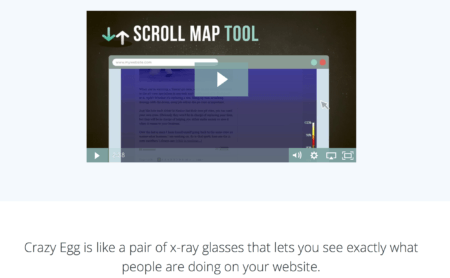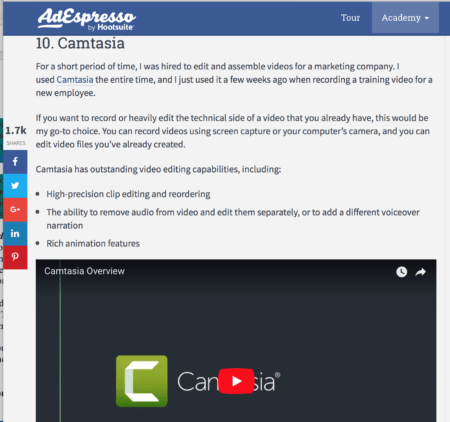How to Incorporate More Video into Your Marketing
by Jacob Baadsgaard • September 15, 2017
We all know that businesses should be incorporating more videos in their marketing, but it’s easy to get stumped trying to figure out how exactly to do so.
There are a number of ways to incorporate video into your marketing strategy, all of which can add value and increase conversions simultaneously.
Many small businesses think that they can’t afford to be regularly using video marketing, but I’d argue that you can’t afford not to. This is true for businesses in both B2C and B2B industries. All the research backs this up, showing that if you aren’t using video you could easily lag behind competitors, including:
- One-third of online activity is spent watching videos (so you want to make sure your videos are part of that)
- 51% of marketing professionals found that video consistently yields higher ROI than all other types of content
- Marketers who use video grow revenue 49% faster than those who don’t
It’s clear that video marketing is important, so in this post we’re going to go over different types of marketing videos and how to leverage them for best results.
Social Media Videos
You know we had to start with social media videos. Social media videos actually generate more than 1200% more shares than text and images combined.
Videos on social media should primarily focus on building relationships and brand awareness, with a heavy emphasis on brand storytelling. This allows you to foster a rapport with your customers by telling them why they should care about your brand. Think soft sell instead of a hard sell.

Social media videos should be under two minutes long in order to maintain decent retention rates, and you need to make the first three seconds interesting enough to get them through those two minutes. Also, it’s always a good idea to use captions. since many social media sites use auto-play videos with no sound in their feeds (and 85% of Facebook videos are thus watched without any sound.

Social media videos can be used in organic traffic, ads (including Pinterest’s newly accessible Promoted Videos), and even in features like Facebook’s new video covers.
Product Videos
You can share product videos on other platforms, but you should absolutely embed them on the actual product page. These videos should be made with users in the consideration stage of the digital sales funnel in mind—they are aggressively showing potential customers why the product is superior quality and why they need to purchase it now.

Product videos should be a priority for businesses. 4x more customers would rather watch a video about a product instead of reading about it and 59% of executives would rather watch a video about a product instead of reading about it.
Product videos can include close-ups on the product, the product in-use, how the product is made and user-generated content or testimonials about the product. “How to care for the product” vidoes can also be placed on the product page and on social media to provide value to customers.
Landing Page Videos
Landing pages with videos have a 53% higher chance of showing up on the first page of search results and the videos themselves can increase conversion rates by 86%.

Videos on landing pages should be focused on users who are in the discovery and consideration stages of the digital sales funnel.
A landing page is designed to introduce your product to consumers with the goal of sales, and is often used for colder audiences. Because of this, incorporating statistics and/or user-generated content in your landing page videos can help win over user interest and trust. Some sites actually have several different videos on their landing page to help with this.

Videos on a landing page should start by explaining the problem the product addresses and then immediately introduce the product as a solution. This is a solid format that will help increase sales while capturing user interest immediately. Potential customers don’t care about you—they care about their problems and pain points.
Videos in Email
Videos within emails aren’t used often, but they should be. Video in an email can increase CTR rates by more than 50%. It may reduce unsubscribe rates by 26% and including “video” in the subject line can increase open rates by 19%.
Videos in email should focus on specific objectives created to appeal to users in different stages of the sales funnel. This can be product sales for those high in the funnel or brand awareness for leads you’re still nurturing.
There are several ways you can add video to email. The most common is the use of GIFs, which are fast-loading and don’t require a lot of data to play. GIFs make an email slightly more dynamic without overwhelming viewers.
You can also embed videos directly into the email. This allows users to view the video in their inbox without having to leave the site or the email mobile app. These videos should be short and to-the-point, preferably 30 seconds or less. You can see an excellent guide on how to embed videos into your email campaigns here.
In case the video or GIF doesn’t load for some viewers, make sure the first frame contains any crucial information you want to share with viewers.
Videos Embedded in Blog Posts
Most blogs focus on text and images, while completely forgetting about video content. However, blog posts containing videos drive about 3x as many inbound links as posts without them. Videos can also strengthen a blog’s point—whether you created the video or not—and can help to make the posts more engaging.
Videos that are embedded in blog posts should seek to strengthen your argument, whatever that is. This includes videos that contain content that can be used as examples, or those that demonstrate your point (the latter of which is demonstrated below).

You can also use videos in blogs to provide further information. In the post below on video editing tools, a video overview is embedded in the blog post. This serves as a tutorial for the tool’s interface and condenses the amount of textual information that users may not necessarily want to read.

Conclusion
Businesses should be using video on every platform, creating them specifically for users at the appropriate stage in the digital sales funnel. This ensures that the most engaging, persuasive type of content is placed at every potential customer touchpoint.
By the way, if you’d like to start incorporating more video into your marketing efforts, let me know here or in the comments. We’d love to help!
What do you think? How do you use videos in your marketing strategy? What’s your biggest challenge with video marketing? Leave us a comment and let us know!





